|
TOWEDNACK
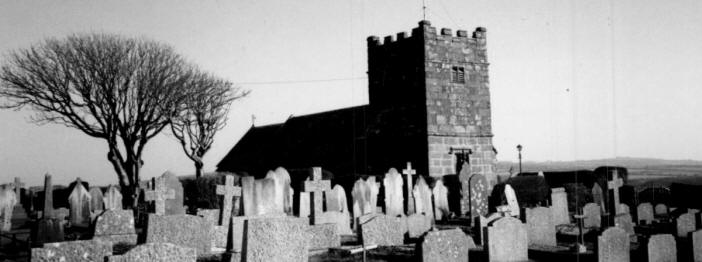
"The parish of Towednack, is only less wild than Zennor, and its 'church-town' (ie
village round the parish church) consists of two farmhouses and an inn. The Church tower,
of granite, very low and massive, is altogether unlike every other in the district, and
being constructed without any attempt at ornamentation."

(This picture shows the church prior to restoration).
Clicking on some of the pictures
will show them enlarged
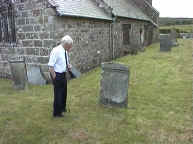
My father (Nick Berryman) examining a Berryman grave in Towednack churchyard.


Desolate landscape around the church
"The continuous parishes of Zennor, Towednack and Morvah are
locally termed the 'high countries' and preserve much of the social aspect of former ages.
Here may still be commonly seen the immense open chimney, with dried furze and turf piled
up on the earthen floor of the kitchen. "
"In the Doomsday Book, the district was taxed under the
jurisdiction Amall, now Amall Veor or Trenwith………… "
"Towednack, like most of the districts situated on granite,
exhibits a strange and almost unaccountable mixture of cultivated and of unreclaimed
soils. On one side of a fence may be seen land producing abundance of grass and excellent
for daisies, or bearing ample crops of barley and of clover hay, and on the other side,
nothing better than the species or variety of furze, Ullex Nanus, and some of the more
coarse grasses."

At one time, the parish of Towednack had about 22 tin mines (the last to close was Giew
in 1923), and the Berryman family doubtless had many tin miners in its ranks. "This
parish has been productive of much tin near the surface; . . . . "
"The parish of Towednack also affords some interesting examples of old Cornish
domestic architecture...... Trevessa(Trevisa), a primitive village
in the parish of Towednack, and one of the old homes of the Stevens clan. The farmstead
probably inhabited, since it was built, by the Quick family. On the lintel: ‘P.J.Q.
1702 (Paul and Jane Quick’)" (a description of
this house is on page 324 of reference 2, and details of the Stevens family on page
451)
At nearby Amalveor farm, once owned by the Berryman family, a gold hoard,
dated at about 1000 B.C, was discovered; it is now in the British Museum, and comprises
two twisted torcs, four plain bracelets, and three coled bars of gold.
Nancledra is a hamlet in Towednack. In the 1327 Subsidy Roll, it
was Nanscludry, which means: "The valley of the sheltered
habitation

Towednack church (St Tewinnoc), was named after a 6th Century
monk, "Winnock" or "Gwynog", of royal British blood. Many years ago,
it was known as the Chapel of St Ewin, and was administered from the nearby parish of
Lelant.
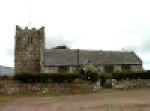
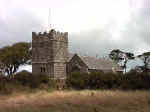

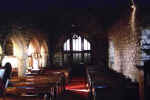
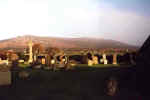

|
The parish registers date to 1676 (an early volume, long since lost, was
copied by a Dr Cardew).
The present church, parts of which date back to the late 13th
century, has an unusually squat and massive tower. "There is an old legend that, when
the mason's were building the tower of this Church, the devil came every night and carried
off the pinnacles and battlements. Again and again this work was renewed during the day,
and as often was it removed during the night, until at length, the builders gave up the
work in despair. Associated with this tower is the proverb: "there are no cuckolds in
Towednack, because there are no horns on the church-tower". Perhaps this is not
unconnected with the celebrated Towednack "Cuckoo Feast".
The stone altar of the church is formed from a rough granite block, and probably dates
from the Norman era; having been disposed of, probably during the Reformation, it was
rediscovered earlier this century forming part of a wall at Churchtown Farm. There were
also two bench ends from about 1633, with the names of Wardens Matthew Trenwith and James
Trewhella carved upon them, but these appear to have been stolen. The font dates partly
from Norman times and partly from 1720.
The Church also has the distinction of being the first in modern times to hold a
service in the Cornish language (1933), and in 1975 was used for the marriage and burial
services in the TV series "Poldark", and again in 1979 in the film
"Penmarric".
"It is an unpleasant and probably erroneous tradition that the bodies in Towednack
churchyard, which is very small, after having lain there for 20 years, were disinterred to
make way for fresh burials, and stowed away in a charnel-house."
Another Towednack legend tells of a local farmer who, at a party, caught and kept a
cuckoo that flew out of a hole in a log that he had placed on the fire. He vowed that he
would thereafter hold an annual feast to celebrate the event, and to this day, on the
nearest Sunday to April 25th, Towednack holds its annual "Cuckoo Feast", with a
fiddler leading a procession from the church door.
"Crying the Neck", a ritualistic thought to have originated as a Neolithic
sacrifice to the corn-spirit was, in the C19th, an integral part of Cornish culture. The
ritual was observed at Towednack until at least the 1930s. |
The last picture of the Church (above) is kindly contributed by Jim Thompson.
Any additional contributions (photos or information) about the parish will be
most welcome.
The Berriman Family
The Berriman line in Towednack was started by Mark Berriman and his wife, Elenor (Eade)
in about 1708. The name probably changed from Berryman to Berriman around the year 1690,
after Mark's parents, Richard and Margaret (Thomas), moved from Porthmeor to
"Churchtown", Zennor. In my branch of the family, it changed back to Berryman in
about 1860.
1.
"The Parochial
History of Cornwall" , founded on the manuscript histories of Mr Hals and Mr Tonkin
(1838).
2 "A history of the parishes of Saint Ives, Lelant, Towednack
and Zennor in the county of Cornwall", by John Hobson Matthews, 1892.
|












